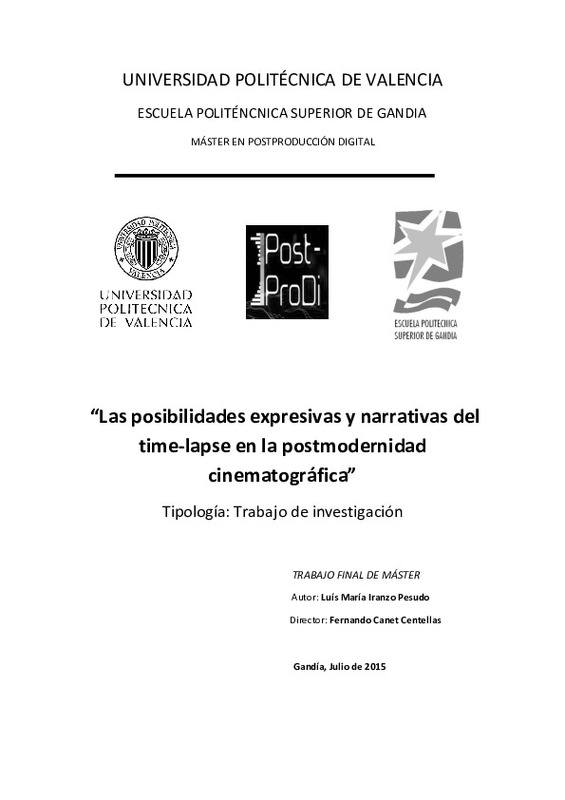JavaScript is disabled for your browser. Some features of this site may not work without it.
Buscar en RiuNet
Listar
Mi cuenta
Estadísticas
Ayuda RiuNet
Admin. UPV
Las posibilidades expresivas y narrativas del time-lapse en la postmodernidad cinematográfica
Mostrar el registro sencillo del ítem
Ficheros en el ítem
| dc.contributor.advisor | Canet Centellas, Fernando Javier
|
es_ES |
| dc.contributor.author | Iranzo Pesudo, Luis María
|
es_ES |
| dc.date.accessioned | 2015-11-09T13:56:24Z | |
| dc.date.available | 2015-11-09T13:56:24Z | |
| dc.date.created | 2015-09-24 | |
| dc.date.issued | 2015-11-09 | es_ES |
| dc.identifier.uri | http://hdl.handle.net/10251/57223 | |
| dc.description.abstract | Desde los videos corporativos hasta la publicidad, internet y la democratización de la tecnología digital han convertido la figura del time-lapse en un recurso omnipresente en el panorama audiovisual actual. Desde el punto de vista cinematográfico, aunque es un recurso que existe desde el cine de los orígenes, ha proliferado sobre todo desde los inicios de lo que podríamos denominar la postmodernidad cinematográfica. El presente trabajo tiene como objetivo detectar y analizar las posibilidades expresivas y narrativas del time-lapse en ese período a través del estudio del montaje de las secuencias de los diferentes textos audiovisuales en los que aparece. Tras la conceptualización y encuadramiento del time-lapse en el seno de la teoría cinematográfica y la narratología aplicada al cine, el análisis realizado por este trabajo de investigación nos lleva del documental experimental Koyaanisqatsi (Reggio, 1982) al cine digital contemporáneo pasando por un modo de narración alternativo, el del cine “indie”, a través de uno de sus máximos representantes: Gun Van Sant. La finalidad es esclarecer si el time-lapse, por su uso masivo y superficial, ha acabado subsumido como un mecanismo más que favorece la espectacularidad del cine postmoderno o, si por el contrario, todavía puede constituir un recurso generador de sentido. | es_ES |
| dc.description.abstract | From corporate videos to advertising, Internet and democratisation process of digital technology have made time-lapse technique an ubiquitous tool in the current audiovisual scene. From a cinematographic point of view, it is a device which exists since primitive films but its use has been especially spread since the earlier days of what we might call film postmodernity. The purpose of the current paper is to guess and analyze the time-lapse expressive and narrative possibilities in that period through the study of the editing of the different audiovisual sequences in which time-lapse appears. Once time-lapse is conceptualized and framed in film theory and narratology, the analysis made by this research work take us from experimental documentary Koyaanisqatsi (Reggio, 1982) to contemporary digital cinema including an alternative way of narrative, “indie cinema”, through one of their maximum exponents: Gus Van Sant. The objective is to clarify if time-lapse, because of being used massive and superficially, has been absorbed like another tool which favors the spectacular nature of postmodern cinema or, on the contrary, it can still become a device which produces sense and meaning. | es_ES |
| dc.format.extent | 111 | es_ES |
| dc.language | Español | es_ES |
| dc.publisher | Universitat Politècnica de València | es_ES |
| dc.rights | Reserva de todos los derechos | es_ES |
| dc.subject | Time-lapse | es_ES |
| dc.subject | Postmodernidad | es_ES |
| dc.subject | Cinematografía | es_ES |
| dc.subject | Montaje audiovisual | es_ES |
| dc.subject | Tiempo narrativo | es_ES |
| dc.subject | Film postmodernity | es_ES |
| dc.subject | Editing | es_ES |
| dc.subject | Narrative time | es_ES |
| dc.subject.classification | COMUNICACION AUDIOVISUAL Y PUBLICIDAD | es_ES |
| dc.subject.classification | BIBLIOTECONOMIA Y DOCUMENTACION | es_ES |
| dc.subject.other | Máster Universitario en Postproducción Digital-Màster Universitari en Postproducció Digital | es_ES |
| dc.title | Las posibilidades expresivas y narrativas del time-lapse en la postmodernidad cinematográfica | es_ES |
| dc.type | Tesis de máster | es_ES |
| dc.rights.accessRights | Abierto | es_ES |
| dc.contributor.affiliation | Universitat Politècnica de València. Facultad de Bellas Artes - Facultat de Belles Arts | es_ES |
| dc.contributor.affiliation | Universitat Politècnica de València. Departamento de Comunicación Audiovisual, Documentación e Historia del Arte - Departament de Comunicació Audiovisual, Documentació i Història de l'Art | es_ES |
| dc.description.bibliographicCitation | Iranzo Pesudo, LM. (2015). Las posibilidades expresivas y narrativas del time-lapse en la postmodernidad cinematográfica. Universitat Politècnica de València. http://hdl.handle.net/10251/57223 | es_ES |
| dc.description.accrualMethod | TFGM | es_ES |
| dc.relation.pasarela | TFGM\27351 | es_ES |
Este ítem aparece en la(s) siguiente(s) colección(ones)
-
EPSG - Trabajos académicos [5004]
Escuela Politécnica Superior de Gandia





![MS Word file [Word]](/themes/UPV/images/msword.png)

